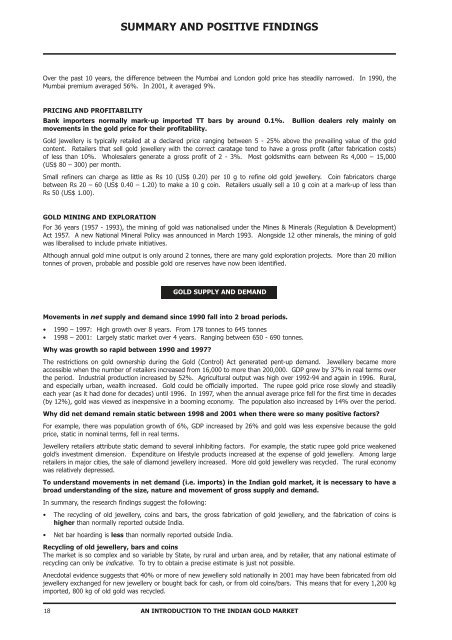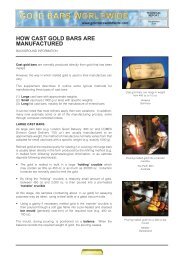Indian Gold Book:Indian Gold Book - Gold Bars Worldwide
Indian Gold Book:Indian Gold Book - Gold Bars Worldwide
Indian Gold Book:Indian Gold Book - Gold Bars Worldwide
Create successful ePaper yourself
Turn your PDF publications into a flip-book with our unique Google optimized e-Paper software.
SUMMARY AND POSITIVE FINDINGS<br />
Over the past 10 years, the difference between the Mumbai and London gold price has steadily narrowed. In 1990, the<br />
Mumbai premium averaged 56%. In 2001, it averaged 9%.<br />
PRICING AND PROFITABILITY<br />
Bank importers normally mark-up imported TT bars by around 0.1%. Bullion dealers rely mainly on<br />
movements in the gold price for their profitability.<br />
<strong>Gold</strong> jewellery is typically retailed at a declared price ranging between 5 - 25% above the prevailing value of the gold<br />
content. Retailers that sell gold jewellery with the correct caratage tend to have a gross profit (after fabrication costs)<br />
of less than 10%. Wholesalers generate a gross profit of 2 - 3%. Most goldsmiths earn between Rs 4,000 – 15,000<br />
(US$ 80 – 300) per month.<br />
Small refiners can charge as little as Rs 10 (US$ 0.20) per 10 g to refine old gold jewellery. Coin fabricators charge<br />
between Rs 20 – 60 (US$ 0.40 – 1.20) to make a 10 g coin. Retailers usually sell a 10 g coin at a mark-up of less than<br />
Rs 50 (US$ 1.00).<br />
GOLD MINING AND EXPLORATION<br />
For 36 years (1957 - 1993), the mining of gold was nationalised under the Mines & Minerals (Regulation & Development)<br />
Act 1957. A new National Mineral Policy was announced in March 1993. Alongside 12 other minerals, the mining of gold<br />
was liberalised to include private initiatives.<br />
Although annual gold mine output is only around 2 tonnes, there are many gold exploration projects. More than 20 million<br />
tonnes of proven, probable and possible gold ore reserves have now been identified.<br />
GOLD SUPPLY AND DEMAND<br />
Movements in net supply and demand since 1990 fall into 2 broad periods.<br />
• 1990 – 1997: High growth over 8 years. From 178 tonnes to 645 tonnes<br />
• 1998 – 2001: Largely static market over 4 years. Ranging between 650 - 690 tonnes.<br />
Why was growth so rapid between 1990 and 1997?<br />
The restrictions on gold ownership during the <strong>Gold</strong> (Control) Act generated pent-up demand. Jewellery became more<br />
accessible when the number of retailers increased from 16,000 to more than 200,000. GDP grew by 37% in real terms over<br />
the period. Industrial production increased by 52%. Agricultural output was high over 1992-94 and again in 1996. Rural,<br />
and especially urban, wealth increased. <strong>Gold</strong> could be officially imported. The rupee gold price rose slowly and steadily<br />
each year (as it had done for decades) until 1996. In 1997, when the annual average price fell for the first time in decades<br />
(by 12%), gold was viewed as inexpensive in a booming economy. The population also increased by 14% over the period.<br />
Why did net demand remain static between 1998 and 2001 when there were so many positive factors?<br />
For example, there was population growth of 6%, GDP increased by 26% and gold was less expensive because the gold<br />
price, static in nominal terms, fell in real terms.<br />
Jewellery retailers attribute static demand to several inhibiting factors. For example, the static rupee gold price weakened<br />
gold’s investment dimension. Expenditure on lifestyle products increased at the expense of gold jewellery. Among large<br />
retailers in major cities, the sale of diamond jewellery increased. More old gold jewellery was recycled. The rural economy<br />
was relatively depressed.<br />
To understand movements in net demand (i.e. imports) in the <strong>Indian</strong> gold market, it is necessary to have a<br />
broad understanding of the size, nature and movement of gross supply and demand.<br />
In summary, the research findings suggest the following:<br />
• The recycling of old jewellery, coins and bars, the gross fabrication of gold jewellery, and the fabrication of coins is<br />
higher than normally reported outside India.<br />
• Net bar hoarding is less than normally reported outside India.<br />
Recycling of old jewellery, bars and coins<br />
The market is so complex and so variable by State, by rural and urban area, and by retailer, that any national estimate of<br />
recycling can only be indicative. To try to obtain a precise estimate is just not possible.<br />
Anecdotal evidence suggests that 40% or more of new jewellery sold nationally in 2001 may have been fabricated from old<br />
jewellery exchanged for new jewellery or bought back for cash, or from old coins/bars. This means that for every 1,200 kg<br />
imported, 800 kg of old gold was recycled.<br />
18<br />
AN INTRODUCTION TO THE INDIAN GOLD MARKET

















